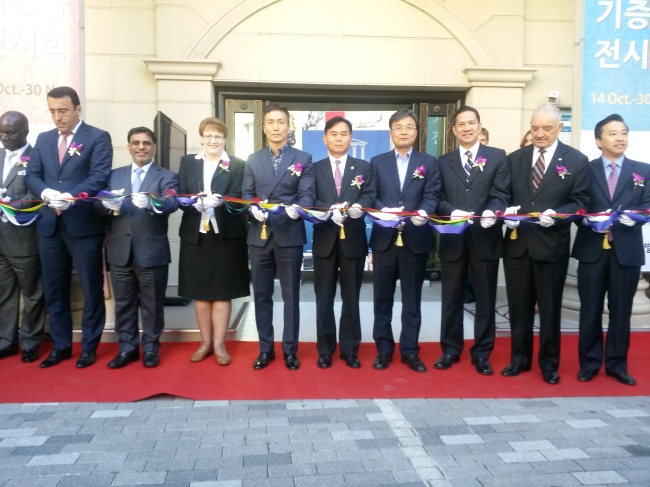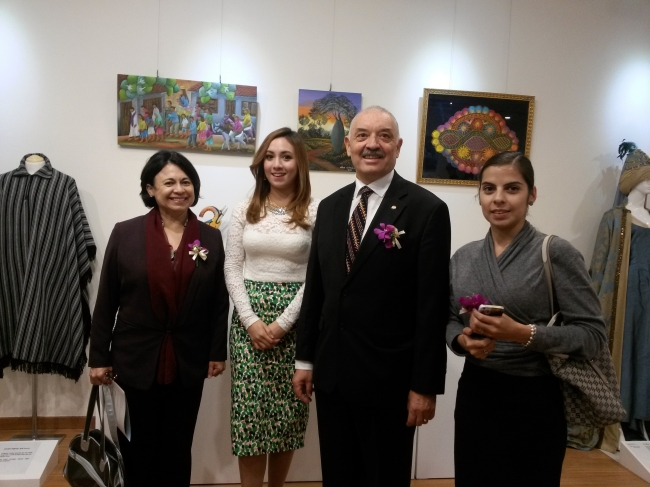Envoys come out for multiculturalism
New exhibition of donations by foreign missions on display at Multiculture museum
By Korea HeraldPublished : Oct. 19, 2014 - 20:38
Whether defined as a “melting pot” or “salad bowl,” multiculturalism in South Korea has received considerable attention for over a decade from critics and proponents alike.
One museum here has made it its mission to promote the salad bowl variety of the concept, celebrating the culture of foreign residents in particular and diversity in general.
Recognizing the value of diversity and cultural understanding, many foreign envoys here have supported the Multiculture Museum and its mission since its opening in northern Seoul in 2011. Twenty-three diplomatic missions have even contributed to the museum’s programs, classes and collection of cultural items from around the world such as traditional outfits and figurines.
On Tuesday, scores of foreign ambassadors, government officials and representatives from other museums in the city participated in the opening of a special exhibition of donations by foreign diplomatic missions to the museum.
One museum here has made it its mission to promote the salad bowl variety of the concept, celebrating the culture of foreign residents in particular and diversity in general.
Recognizing the value of diversity and cultural understanding, many foreign envoys here have supported the Multiculture Museum and its mission since its opening in northern Seoul in 2011. Twenty-three diplomatic missions have even contributed to the museum’s programs, classes and collection of cultural items from around the world such as traditional outfits and figurines.
On Tuesday, scores of foreign ambassadors, government officials and representatives from other museums in the city participated in the opening of a special exhibition of donations by foreign diplomatic missions to the museum.


“What is most important is that this exhibition provides an opportunity for people who maybe cannot afford to travel around the world. They can come here to get a taste of the cultures of people from around the world,” said Paraguayan Ambassador to South Korea Ceferino Valdez.
The museum was the brainchild of Kim Yoon-tae, the museum’s director. Kim said he opened the museum because he saw a need in South Korea for a center that would help raise awareness of peoples and cultures around the world.
“This exhibition is great for us because we can display examples of Omani heritage, traditions, our history and culture. And in general, it brings people together, too. It can be considered as a kind of cultural bridge between peoples of different cultures,” said Omani Ambassador Mohammed bin Salim Al Harthy.
As Kim saw it, people from dozens of countries are coming here to live, work and study. An increasing number of foreigners are now calling South Korea home.
Despite the growing foreign community, however, the public still lacks sufficient understanding of the larger world, Kim said.
“This kind of collaboration and also exchange of cultural items can increase and enhance people-to-people exchanges. This exhibition will strengthen our relationship and cooperation,” said the Philippines Ambassador Raul S. Hernandez.
Though still small, the number of foreign residents increased to more than 1.5 million this year, according to recent media reports, up more than 10 percent from the previous year. Foreign residents make up about 3 percent of the country’s total population.
But the growing community has not always been made to feel welcome.
After a weeklong investigation into racism and xenophobia here, U.N. Special Rapporteur Mutuma Ruteere said on Oct. 6 that it was clear South Korea faced challenges related to its growing foreign community.
In addition to encouraging the government to pass antidiscrimination legislation, “South Korean authorities (need) to fight racism and discrimination through better education, as well as ensuring that the media is sensitive and conscious of the responsibility to avoid racist and xenophobic stereotypes,” according to a press statement on the website of the Office of the High Commissioner for Human Rights.
But just days after he left South Korea, Donga Ilbo, one the country’s largest news dailies, published a report on Oct. 10 that warns Korean women “to be wary of foreign men” buying them a drink at a night club. The report warns all Korean women of “foreign men,” based on innuendo and two vague allegations.
Examples of racial insensitivity here have recently garnered international attention. In August, a bar in Itaewon tried banning “Africans” from entrance “due to Ebola.” Earlier this year, an advertising campaign for a cigarette brand, This Africa, featured a chimpanzee dressed as a news broadcaster. Periodic incidents of performers wearing blackface on major TV networks here to solicit cheap laughs attracted international attention this year.
To its credit, the government investigated recent reports of overt discrimination against migrant workers hired as low-paid, unskilled manual laborers. It was those complaints that instigated the visit by the U.N.
Some workers complained that they had to leave the country before receiving regular severance pay required by law, according to the OHCHR press statement.
Ruteere highlighted the plight of migrant workers in the agriculture and fishing sectors ― besides suffering tough working and living conditions, they “generally work longer hours for less pay than their Korean counterparts.”
Immigration policies in Korea are relatively strict. E-9 visas, the ones granted to low-skilled foreigners, allow eligible foreigners to work a maximum of four years and 10 months in manufacturing, agriculture, fishery, construction and a few services industries.
Many foreign envoys highlighted the constructive role the Multiculture Museum is playing in promoting sensitivity and bridging cultural barriers between South Korean and foreign residents.
The museum provides multicultural classes for children at its facilities and brings “multicultural emissaries,” usually foreign students, to the museum and local schools to present tutorials. It also hosts special luncheons that showcase national and traditional cuisines.
“South Korea is changing rapidly from being a country of one culture to being a place where different cultures coexist and prosper together. South Korea is not a Third World country anymore that has attracted no attention from the world community,” said Kim Yun-tae.
“I think then the time has come when we should not only try to promote our own culture and language but listen carefully to other cultures and to what they have to tell us.
“Yes, it is very important to promote our own culture, but to listen and comprehend the other side is no less an important task, and that is why I truly believe that this exhibition is important,” Kim said during the opening reception.
By Philip Iglauer (ephilip2014@heraldcorp.com)
-
Articles by Korea Herald


![[AtoZ into Korean mind] Humor in Korea: Navigating the line between what's funny and not](http://res.heraldm.com/phpwas/restmb_idxmake.php?idx=644&simg=/content/image/2024/04/22/20240422050642_0.jpg&u=)
![[Exclusive] Korean military set to ban iPhones over 'security' concerns](http://res.heraldm.com/phpwas/restmb_idxmake.php?idx=644&simg=/content/image/2024/04/23/20240423050599_0.jpg&u=20240423183955)



![[Graphic News] 77% of young Koreans still financially dependent](http://res.heraldm.com/phpwas/restmb_idxmake.php?idx=644&simg=/content/image/2024/04/22/20240422050762_0.gif&u=)
![[Herald Interview] Why Toss invited hackers to penetrate its system](http://res.heraldm.com/phpwas/restmb_idxmake.php?idx=644&simg=/content/image/2024/04/22/20240422050569_0.jpg&u=20240422150649)






![[Exclusive] Korean military to ban iPhones over security issues](http://res.heraldm.com/phpwas/restmb_idxmake.php?idx=652&simg=/content/image/2024/04/23/20240423050599_0.jpg&u=20240423183955)



![[Today’s K-pop] Ateez confirms US tour details](http://res.heraldm.com/phpwas/restmb_idxmake.php?idx=642&simg=/content/image/2024/04/23/20240423050700_0.jpg&u=)